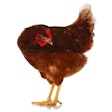
Highly pathogenic avian influenza (HPAI) outbreaks in South Africa have led to supply problems in other countries that previously relied on its poultry exports. Despite further reported cases, the South African producers’ association reports that the sector is on the road to recovery.
One aspect of the recent crises in the South African poultry sector that has received little attention is the impact on international trade.
Previously, the country was the leading exporter of chicken meat and eggs to other parts of the continent, according to The Africa Report.
As a result of HPAI, most of its former trading destination banned imports of these products from South Africa, and the result has been widespread disruption of the African poultry market.
Early signs of improvement in avian flu situation
In the nation’s battle to control HPAI, there may be some light at the end of the tunnel for South Africa’s poultry industry.
According to the South African Poultry Association (SAPA), there are signs that the number of newly confirmed outbreaks is dwindling. Furthermore, it says, there are grounds for optimism as fertile eggs are arriving to restock depleted flocks, and approval of a vaccine is in discussion.
In April of this year, an uptick in cases of HPAI in poultry linked to the H5N1 virus serotype marked the start of a new disease “season” for South Africa. In reality, outbreaks had been ongoing already for several months. By the end of May, the country had also confirmed outbreaks in commercial birds involving the H7N6 variant. These were the country’s first detections of the latter virus serotype.
As the viruses spread, mortalities and culling of poultry looked to be threatening the supply of eggs on the domestic market.
By mid-November, Reuters reported that concerns were being expressed concerns about possible shortages of chicken meat in South Africa ahead of the festive season. Citing figures from SAPA, the source referred to the loss of six million laying hens and 2.5 million breeder chickens.
To ease these market difficulties, the agriculture department announced it had increased imports of both table and hatching eggs, as well as powdered and liquid egg products.
The HPAI outbreaks came at a particularly bad time for South Africa’s poultry sector, which was also struggling to manage prolonged periods of high feed prices and power cuts (load shedding”).
Measures mitigate domestic poultry market disruption
In November, SAPA issued a statement that the sector was on the road to recovery. It assured the public that any shortages of chicken meat over the holiday period would be “minimal,” following a series of actions it had taken to mitigate the impacts of the disease on the market.
Among these measures were the extension of the laying period for healthy egg flocks by 2-3 weeks. As well as including second-grade eggs for hatching, 83 million broiler hatching eggs had been imported since early October. SAPA also reported that higher-than-usual stocks of frozen chicken will help supply the market for chicken over the holiday period.
At the time, discussions were ongoing on how the 3.5-billion rand (ZAR; US$186-milliion) compensation scheme for farmers affected by HPAI will be distributed.
South Africa confirms further HPAI outbreaks
Over the past month, the national animal health agency has officially reported a further 22 HPAI outbreaks involving either the H5N1 or H7N6 virus serotypes.
The newer arrival — H7N6 — has been detected at 14 more poultry farms, according to the latest notifications to the World Organisation for Animal Health (WOAH).
In outbreaks starting between late August and November 9, these directly impacted a total of around 2.06 million birds. Affected premises were located in six provinces — Eastern Cape, Free State, Gauteng, Limpopo, North West, and Western Cape. While the majority were described in the reports as “farms,” one was a village flock, and another a backyard with 52,000 poultry. Individual flock sizes ranged from around 27,000 to 600,000. Among them is the first flock of commercial ostriches found to be infected with this virus serotype.
Since the country’s first cases linked to the H7N6 virus variant, 108 outbreaks involving almost 10.38 million birds have been registered with WOAH.
Meanwhile, the H5N1 HPAI serotype has been detected at 22 premises in South Africa. Outbreaks affecting around 1.49 million farmed birds were confirmed between the start of the current “season” in mid-April and October 25.
With start dates since mid-August, the latest eight outbreaks notified to WOAH affected 24,000 birds at six locations in Western Cape, and first outbreaks in the series in Northern Cape and North West. Five of the affected flocks in Western Cape comprised commercial ostriches.
Avian flu situation elsewhere in Africa
Since the start of October, HPAI virus has been detected in two countries in sub-Saharan Africa, according to the latest update on the disease situation from the United Nations’ Food and Agriculture Organization (FAO; as of November 16).
As well as 12 outbreaks linked to the H5 virus family and 54 to the H7N6 serotype in South Africa, there has been one outbreak in commercial laying hens in Mozambique. FAO has recorded no further cases in this East Africa state.
In Nigeria, an expert group supported by FAO has advised the government to maintain a policy of not vaccinating poultry against HPAI.
Widespread prevalence of avian influenza viruses in African poultry has been demonstrated in a research paper mentioned by FAO.
Surveillance of backyard poultry at 15 live markets in Morocco revealed that more than 60% of the samples taken from birds have tested positive for a low-pathogenic form of the H9N2 flu virus. Presence of the virus represents a possible future risk to human and bird health.
View our continuing coverage of the global avian influenza situation.

















